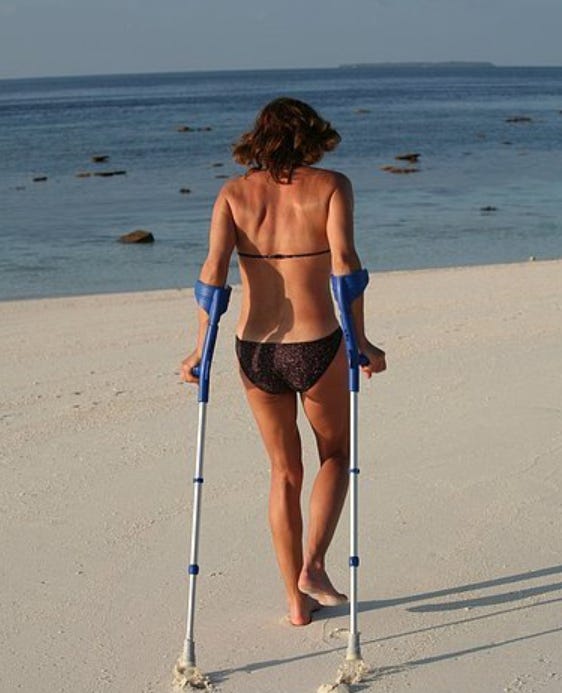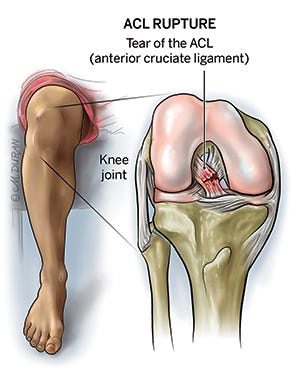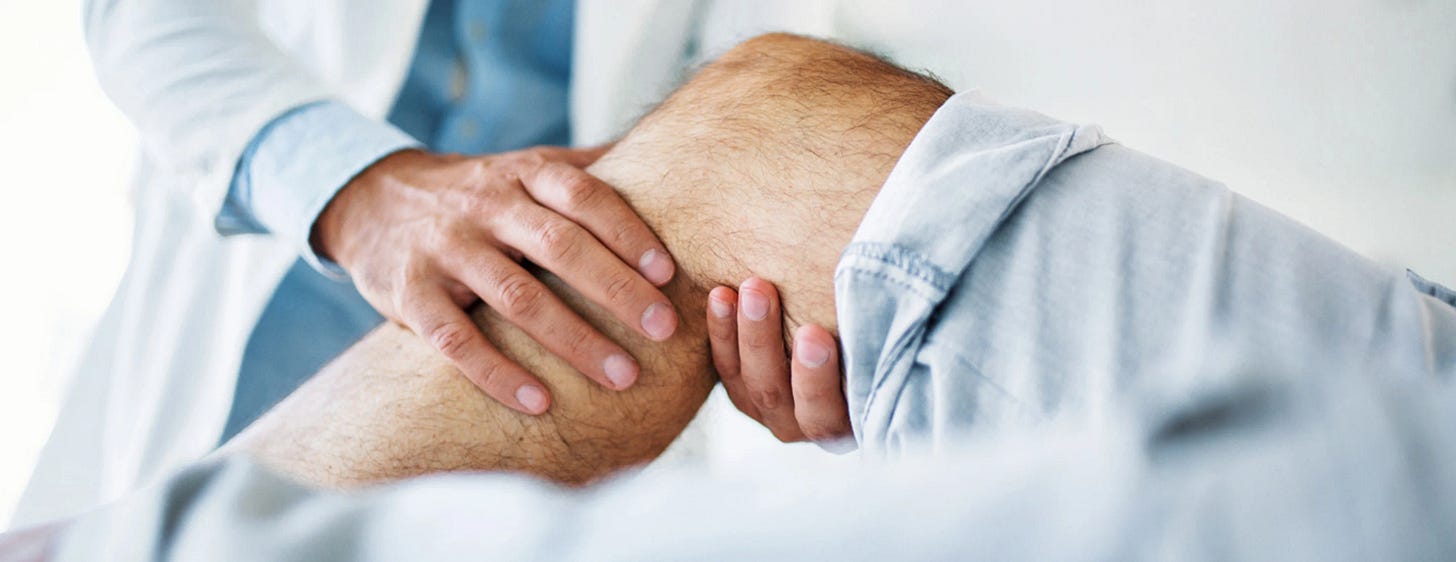The Missing Link in ACL Injury Prevention? It’s in Your Vitamins! Study analysis of Pasquini et.al.
Could surgeons and physicians be missing the key to ACL health?
Anterior cruciate ligament (ACL) injuries are among the most feared setbacks in athletics and active lifestyles, often requiring surgical intervention and lengthy recovery periods. We had just that case a few months ago when we had a patient show up with a complete tear. She was hit on the ski slope. With a family history of severe arthritis and early total knee replacements, she knew the cards were stacked against her. We immediately checked her metabolic health, began a program of energy modalities and peptides, when improved we proceeded with a protocol of Cross Brace BPC-157, TB-500, AOD9604, then PRP at 4 billion platelets per mL and BMC stem cells.
Image and name changed to protect anonymity
This was followed by Vitamin D support, mandatory trips to Turks and Caicos for beach and sun. All the while our excellent DPT was using energy therapies like AltPOINT PNE, Shockwave and Class IV laser. The thing that made the biggest impact? Tough to tell, but the quickest part of her recovery was always after the trips in the sun. So, it is with that observation that I felt I must post on a new-ish study.
Recent insights from a systematic review published in the Journal of Experimental Orthopaedics shine new light on how something as simple as vitamin D could significantly impact ACL injury risk and postoperative outcomes. I want to review this because we have been having excellent success with our ACL tears. Dr Altman and I have been using regenerative medicine techniques with mesenchymal stem cells, platelet rich plasma, mitochondrial transfer, laser, shockwave ultrasound and electrical stimulation with PNE and frequency Specific microcurrents. The tools once reserved only for professional athletes and special forces are now available to you. We have healed, fully torn ACLs with these tools at Concierge Medical, so I was excited when this study came across my desk.
Key Findings on Vitamin D and ACL Health
Increased Injury Risk with Low Vitamin D: A substantial retrospective study revealed that individuals with low vitamin D (<30 ng/mL) were nearly twice as likely to experience an ACL tear. Patients with insufficient vitamin D had an 81% greater risk of sustaining an ACL injury within two years compared to those with optimal levels.
Better Muscle Recovery Post-Surgery: Post-ACL reconstruction, patients with sufficient vitamin D demonstrated significantly stronger muscle recovery, particularly in the quadriceps. One key study noted up to six times better recovery of muscle strength in vitamin D-adequate individuals compared to deficient ones.
Clinical and Athletic Training Guidance
Given these findings, both clinicians and athletes can take actionable steps:
Routine Vitamin D Screening: Incorporate routine vitamin D screenings, especially for athletes and physically active individuals. Aim to maintain serum vitamin D levels above 40 ng/mL.
Preoperative Optimization: Avoid surgery if you can, but absolutely before ACL reconstruction, evaluate and correct vitamin D deficiencies to potentially improve postoperative outcomes and rehabilitation efficacy. In fact we also recommend XR
Supplementation and Lifestyle Adjustments: Recommend regular vitamin D supplementation for those at risk, especially during periods of limited sunlight exposure (e.g., winter, indoor training).
Enhanced Rehabilitation Protocols: Combine traditional physical therapy with nutritional strategies that include vitamin D optimization to enhance muscle recovery and overall joint health.
Practical Takeaways for Patients and Athletes
Check your vitamin D levels annually, especially if you play high-risk sports or have limited sunlight exposure.
Discuss supplementation options with your healthcare provider to achieve optimal vitamin D status.
Prioritize a diet rich in vitamin D (fatty fish, fortified foods, and dairy) alongside safe sun exposure.
During ACL recovery, maintaining optimal vitamin D levels might accelerate your muscle strength recovery, potentially shortening the rehabilitation timeline. At Concierge Medical we tell patients to get to the beach and put their feet in the sand. Not just for optimal levels of Vitamin D, but to shorten the recovery!
Looking Forward
Further studies, especially randomized controlled trials, will help clarify the full potential of vitamin D in injury prevention and recovery. For now, optimizing your vitamin D level emerges as a practical, evidence-based strategy to support musculoskeletal health, reduce injury risk, and facilitate a faster return to your active lifestyle.
For Physicians/Clinicians Main Findings:
Muscle Strength Recovery: Three studies highlighted a clear correlation between vitamin D levels and muscle strength recovery post-ACLR. Patients with adequate vitamin D exhibited greater muscle strength recovery, reduced muscle fiber atrophy, and better neuromuscular function. Barker et al. notably found a six-fold improvement in isometric force recovery in vitamin D-sufficient patients compared to deficient ones. Surgeons and Physiatrists alike MUST BE CHECKING VITAMIN D levels and correcting the issue. Sun first, Oral second.
Functional Outcomes and Bone Health: The relationship between vitamin D and broader functional outcomes (like return to sport) and bone health (BMD) was less conclusive. Gupta et al. found no significant differences in functional scores (Lysholm, WOMAC), although there was a slightly improved Tegner activity score in patients with sufficient vitamin D. Bone density outcomes post-ACLR also showed mixed results, suggesting vitamin D's role here might be less direct or require a longer follow-up period for clear outcomes.
Strengths:
The review effectively synthesizes data from diverse, high-quality observational studies.
Highlights vitamin D as a potentially modifiable factor to reduce ACL injury risk and enhance postoperative muscle recovery.
Addresses relevant biochemical mechanisms, including vitamin D's roles in muscle function and inflammation regulation.
Limitations:
Lack of randomized controlled trials (RCTs), limiting causal conclusions.
High heterogeneity in vitamin D dosing, outcome assessments, and follow-up periods across studies.
Limited data on long-term functional outcomes and BMD changes after ACLR.
Practical Implications for Orthopedics & Sports Medicine:
Screening and Optimization: Preoperative screening for vitamin D levels must become a standard practice, especially in athletes or individuals with high physical demands.
Rehabilitation Protocols: Incorporation of vitamin D supplementation and monitoring during rehabilitation may accelerate muscle recovery, improving functional outcomes post-ACLR.
Preventive Measures: Educating patients about maintaining adequate vitamin D through diet, supplementation, and lifestyle adjustments could reduce ACL injury risks.
Recommendations for Future Research:
Conducting well-designed randomized controlled trials to assess causality.
Investigating optimal vitamin D supplementation doses and treatment windows pre- and post-ACLR.
Examining long-term functional outcomes and bone health implications related to vitamin D status.
Overall Grade and Impact Assessment:
Overall Grade: B+
Strengths: The systematic review effectively highlights a meaningful clinical relationship between vitamin D levels and ACL injury and recovery outcomes. The included studies have generally high methodological quality and provide valuable insights into preventive strategies and clinical care enhancements.
Limitations: The absence of randomized controlled trials (RCTs) limits the ability to make strong causal claims, and variability in the studies' methods reduces overall clarity and applicability.
Impact Factor of Journal:
Journal: Journal of Experimental Orthopaedics
Impact Factor: Approximately 2.1 (recent available data, subject to annual variation)
This indicates the journal has moderate influence within orthopedics and sports medicine research circles, and while this study contributes valuable clinical insights, its overall impact may be constrained by methodological limitations and the moderate reach of the publication itself.
Overall, it's a useful study that clearly suggests practical clinical implications, but further high-quality research (especially RCTs) is needed to elevate its impact.
Do you want to see what we do for our patients in the practice? If So, keep reading.
Clinical Guidance on Preventing ACL Injuries
A comprehensive strategy to prevent ACL injuries should integrate laboratory testing, targeted physical training, regenerative treatments, and longevity-focused lifestyle modifications.
Annual laboratory testing for serum vitamin D (25-Hydroxyvitamin D) levels is recommended, aiming for optimal levels of 40–60 ng/mL. Supplementation should be adjusted based on deficiency levels: 5,000 IU daily for deficiency (<30 ng/mL), 2,000–3,000 IU daily for insufficiency (30–40 ng/mL), and 1,000–2,000 IU daily for maintenance (>40 ng/mL). Additionally, monitoring inflammatory markers such as C-reactive protein (CRP) and erythrocyte sedimentation rate (ESR) is crucial, with lifestyle interventions including an anti-inflammatory diet, omega-3 fatty acids, curcumin, and resveratrol supplementation, as well as optimized sleep to maintain low inflammation.
Hormonal panels, particularly estrogen and progesterone, should be evaluated regularly in female athletes due to their significant impact on ligament laxity and injury susceptibility.
Physical strengthening and functional training play pivotal roles in ACL injury prevention. Regular exercises such as squats, lunges, leg presses, deadlifts, and Nordic curls are essential, with a focus on maintaining muscular symmetry—ideally a hamstring-to-quadriceps strength ratio of approximately 60–80%, performed at least twice weekly.
One of the best exercises to strengthen an ACL to prevent tears is simple Lex Extensions. Nothing crazy, just isolated quad extensions.
Neuromuscular control and balance exercises, including plyometrics, lateral bounds, single-leg drills, and proprioceptive training with balance boards or Bosu balls, should be conducted 2–3 times weekly.
Additionally, regular core stability and gluteal activation routines such as planks, bridges, hip thrusts, and resistance band exercises should be incorporated at least 2–3 times per week.
Flexibility and mobility practices, emphasizing hip flexors, hamstrings, calves, and ankle joints, with dynamic warm-ups before and static stretches after training sessions, further enhance injury resistance.
Longevity-oriented regenerative therapies can further support ACL health. Optional peptide therapies such as BPC-157, dosed at 250–500 mcg daily, and Thymosin Beta-4, at 300 mcg daily during high training loads or recovery periods, We like TB-500 as well as AOD-9604 especially in patients like this one with OA family history. This stack may promote ligament healing and reduce inflammation. Platelet-rich plasma (PRP) injections can help patients proactively strengthen ligaments in high-risk individuals or those with previous ACL injuries. Hyperbaric oxygen therapy (HBOT), administered 3-5 times weekly, is beneficial for reducing inflammation, enhancing tissue repair, and improving overall recovery, particularly during intense training phases.
Our protocols at Concierge Medical Associates include all of the above. Want to learn exactly how to do it?
Become a Physician Founder.
As a Physician Founder, you're embarking on a one-of-a-kind week of advanced longevity training, positioning yourself at the cutting edge of integrative medicine and metabolic rejuvenation. Each day on-site at Concierge Medical Associates is packed with detailed training sessions, hands-on sessions, and unparalleled access to our complete library of clinical longevity protocols—GLP-1 therapies, senolytics, mitochondrial enhancement, hormone optimization, and cognitive renewal strategies.
You'll gain deep, actionable expertise, mastering precise peptide administration, integrative nutrition strategies, functional medicine interventions, and detailed monitoring methods designed for high-performance longevity care. At the end of your week, you'll confidently bring back a comprehensive toolkit to elevate patient care and grow your practice as a recognized leader in regenerative and longevity medicine.
This Founder Membership Week is more than training—it's transformative.
Whether you're seeking profound personal health transformation or professional mastery in longevity medicine, the Concierge Medical Associates Founder Membership sets you apart. This is your chance to join a select community reshaping the future of health and vitality.
Are you ready to claim your Founder experience?
Spots are limited—reserve your Founder Membership now and step boldly into your most vibrant, energized future.
For Our Patient Founders:
Your week kicks off an extraordinary journey toward vibrant longevity. As a Patient Founder, you're not just getting medical care—you're receiving an exclusive, personalized blueprint to reverse aging at a cellular level. You'll begin with a comprehensive biological assessment, pinpointing your unique markers of aging, inflammation, and metabolic health.
During this transformative week, you'll partner directly with Dr. Murphy and our longevity experts for tailored coaching, diving deep into cutting-edge regenerative therapies, peptides, nutritional strategies, and lifestyle interventions. Each day unfolds a fresh discovery, from mastering mitochondrial health and enhancing cognitive performance, to integrating advanced peptide therapies like GLP-1 agonists, BPC-157, NAD+ precursors, and more.
After your immersive week, your journey continues with 12 monthly longevity coaching sessions, ensuring consistent, measurable progress toward your healthspan goals. This is more than longevity medicine—it's your pathway to extraordinary living.
Lifestyle recommendations integral to ACL injury prevention include adopting an anti-inflammatory diet rich in vegetables, lean proteins, and healthy fats like avocado and olive oil, while minimizing processed foods and sugars. Ensuring consistent, high-quality sleep (7–9 hours nightly) and utilizing recovery techniques such as cryotherapy, infrared saunas, or contrast hydrotherapy regularly are also recommended.
Finally, consistent monitoring through annual physical exams and regular functional movement assessments (e.g., FMS tests, and better) is vital for early detection and correction of imbalances, significantly contributing to long-term joint health and athletic longevity.
Summary
Employing this multifaceted approach—encompassing nutritional optimization, targeted strength and balance training, regenerative therapies, and lifestyle adjustments—can substantially reduce ACL injury risks, expedite recovery processes, and sustain athletic performance and mobility over the long term.
Below is my clinical synopsis that breaks, lab levels, dosages and regimens.
Keep reading with a 7-day free trial
Subscribe to Longevity Insider with Dr. Murphy to keep reading this post and get 7 days of free access to the full post archives.








